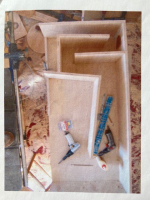Does anyone offer a service to test out a horn design I have been working on? I'm happy to pay someone for their time, and I do not have the time to learn a new program/workflow. Thanks!
Hello and welcome to diyAudio!
By "test out" do you mean building and measuring or just simulating?
By "test out" do you mean building and measuring or just simulating?
I’ve drawn the cabinet in elevation and section with folds and I know the volume. I’m having it drawn up in 3D now for output to CNC, going to use HDF as the sheet material for the box and folds. Fold paths will be routered into the interior sidewalls for bracing. It’s a variant of an existing design that I’ve tweaked using AI to generate and locate the mouth as a tractrix curve…so I’d like to run the model through something like HornResp for testing and tweaking of the angles and pathways. As a newly I’m not sure how much to trust AI’s advice hehehe.
Do you know hornresp?HornResp for testing and tweaking of the angles and pathways
It uses simplified, round and straight-aligned horn sections. More complex simulation of folded horn it is not possible.
I suspect simple AI is completely useless for a complex acoustic project. But I may be wrong.
What kind of horn is it?
Front/back loaded?
What frequency range?
What driver do you use?
Thanks for the follow up @stv , Please see the pdf below. I know this design (shown in the photo) works, I have heard 2 different sets of them, and they are lovely. AI seems to have been quite competent at reading the drawing and providing quite detailed insights to the horn path length and geometry, throat placement, size and shape. -At least to my uneducated self. It proposed reducing the shoulder from a 4" height to a 1", lowering the convergence point of the mouth to the base of the interior cabinet floor and optimizing the mouth shape from a hybris parabolic/exponential curve to the tractrix curve shown on the PDF. Before I actually start the build I'd love to model these changes if at all possible. My plan was to hopefully have someone who knows Hornresp run the data and see how they might be contstrained or optimized further if possible. The driver will be a Fostex FE208ez (unless there is a better suggestion?). I will have the crossover designed for this driver and config. AI seems to have been quite competent at reading the drawing and providing quite detailed insights to the horn path length and geometry, throat placement, size and shape. -At least to my uneducated self. It proposed reducing the shoulder from a 4" height to a 1", lowering the convergence point of the mouth to the base of the interior cabinet floor and optimizing the mouth shape from a hybris parabolic/exponential curve to the tractrix curve shown on the PDF. Before I actually start the build I'd love to model these changes if at all possible.
Attachments
In my opinion:
This is more a transmission line (quarter wavelength resonator) than a true horn.
Seems a bit old fashioned to me with the driver at the start of the line.
Restricted "karlsonator" opening of the "horn" turns it to act more like a mass loaded quarter wave resonator.
It's possible to very roughly simulate it. I can try to have a go if you provide the driver TSP and give me some days.
This is more a transmission line (quarter wavelength resonator) than a true horn.
Seems a bit old fashioned to me with the driver at the start of the line.
Restricted "karlsonator" opening of the "horn" turns it to act more like a mass loaded quarter wave resonator.
It's possible to very roughly simulate it. I can try to have a go if you provide the driver TSP and give me some days.
Was just writing that (and failing to find it). What I recall is that he built it ELEVEN times to get it the way he wanted it with a certain rise around 110Hz for cello. Should be on AA. I would ask mods to split this stuff from David's software thread here to a separate one for your project.
Really? Interesting, sounds just like Bill...I didn't get the chance to get to know him before he died, but we are close with his wife and live in the same village. (My summer project will be restoring his original prototype bass horn. It's in a barn nearby.) I haven't really started my search but these are meant (but not required) to have his AH! cast aluminium horns mounted as well. It will be tough to find a pair, but I also have the ability (with his wife's blessing) to recast an original set if needed.
The drawings I have of his are missing the front elevation locating the mouth, and I can directly measure the set in the photograph, but then I went down the optimization route. I also had a hunch his precision measurements to the /64th" were not accidental, and discovered (uncovered) that the volumterics are all golden ratio and pi driven.
The drawings I have of his are missing the front elevation locating the mouth, and I can directly measure the set in the photograph, but then I went down the optimization route. I also had a hunch his precision measurements to the /64th" were not accidental, and discovered (uncovered) that the volumterics are all golden ratio and pi driven.
Last edited:
@grindston raises an important point, the FE208E-Sigma's of today (E) are not the Sigma's Bill had designed these for....1998 -2001 production. Here are those specs for comparison (irrelevant bc I cannot get those anyway, just for comparison's sake).
Key Specifications
- Nominal Impedance: 8 ΩFostex International+2Loudspeaker Database+2Fostex(フォステクス) | 音は心の広がり+2
- Resonance Frequency (Fs): 45 HzdiyAudio+6Loudspeaker Database+6rutcho.com+6
- Sensitivity: 96.5 dB/W/mdecware.com+7rutcho.com+7Fostex International+7
- Frequency Response: 45 Hz – 20 kHzdiyAudio+5Fostex(フォステクス) | 音は心の広がり+5Fostex International+5
- Rated Power: 34 W (Music Power: 100 W)Fostex International+1rutcho.com+1
- DC Resistance (Re): 6.7 ΩdiyAudio+4Fostex International+4rutcho.com+4
- Qts: 0.21rutcho.com+1db.audioasylum.com+1
- Qes: 0.23
- Qms: 4.03Audiokarma+5rutcho.com+5db.audioasylum.com+5
- Vas: 36.9 litersrutcho.com+1Fostex International+1
- Xmax: 0.75 mmFostex International
- Effective Diaphragm Radius: 81 mmFostex International
- Magnet Weight: 1.7 kgrutcho.com+2Fostex International+2Audiokarma+2
- Net Weight: 3.8 kg
I tried to unwrap your "horn" shape - it seems to have some narrowing after the first segment!
I used the advanced center line method and then simplified the result to model it in hornresp:

This is the resulting response simulation:
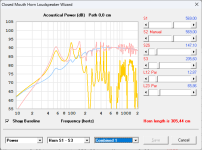
red: combined response
blue: driver output
yellow: port output
the port output will most probably be slightly less ragged in the upper range because of the line bends, the karlsonator port and eventual lining.
I guess you can improve the horn development of the first segments.
and please keep in mind: this simulation is so simplified that it won't accurately predict your very complex proposed enclosure!
But it does show that there will be some severe peaks and dips in the lower range that are inherent to a transmission line with the driver at the very start of the line.
These dips and peaks will still be there, even with the bends, karlsonator port and lining.
(And: AI has not the slightest clou about acoustic simulation and more advanced speaker enclosures. It's still too young for that but not young enough to openly admit it)
I used the advanced center line method and then simplified the result to model it in hornresp:
This is the resulting response simulation:

red: combined response
blue: driver output
yellow: port output
the port output will most probably be slightly less ragged in the upper range because of the line bends, the karlsonator port and eventual lining.
I guess you can improve the horn development of the first segments.
and please keep in mind: this simulation is so simplified that it won't accurately predict your very complex proposed enclosure!
But it does show that there will be some severe peaks and dips in the lower range that are inherent to a transmission line with the driver at the very start of the line.
These dips and peaks will still be there, even with the bends, karlsonator port and lining.
(And: AI has not the slightest clou about acoustic simulation and more advanced speaker enclosures. It's still too young for that but not young enough to openly admit it)
Last edited:
I guess it makes sense to propose an alternative "HI" (human intelligence) solution.AI has not the slightest clou about acoustic simulation
I would build an offset port tapered TL, very similar size as you proposed.
hornresp schematic with filling (wool/polyfill ~10kg/m3 shown in grey shading):
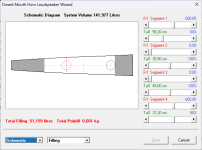
very rough drawing following the hornresp model above and your enclosure dimensions:
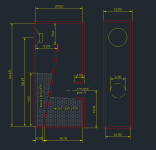
simulated response (red combined, blue driver, yellow port):
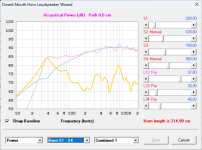
and with a very simple high shelf filter for a more even response:
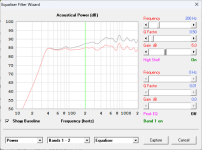
we could still optimize the port, just in case you have access to a 3d printing facility!
Last edited:
Sorry for the delay in response @stv and thank you very kindly for your work. The proposed changes are a big departure from the original spec'd cabinet by Bill Woods, and apparently he built 13 iterations of this cabinet. I am still very new to this world and learning on the fly. From a listner perspective, how would you characterize the experience listening in an A/B audition? Just curious.
Building and testing is the best method, of course. But it takes time and effort.The proposed changes are a big departure from the original spec'd cabinet by Bill Woods, and apparently he built 13 iterations of this cabinet.
I had the impression you used AI to change the original 13-iteration-optimized enclosure, which can only ruin the system. AI has no idea of complex acoustic systems. So I thought a simple mass loaded offset port speaker will surely be better than a purely guessed modification of a thoroughly developed enclosure.
This is just guessing, but the severe peaks in the low range might produce a one-, two- or three-note bass experience that may be worsened (or eventually improved) by room influence.From a listner perspective, how would you characterize the experience listening in an A/B audition?
Understood. What I had been asking AI for was to analyze the mouth area, mouth area and placement to see if it would have any insights. It's reply was very convincing, all the more so because I have zero knowledge base hehehe. But it did propose an alternate opening with some justification, again, I have no way to know if it was all just an impressive string-of-words or actual insight based on wave propagation. Attached is the tractix curve mouth opening is supplied as an alternate more efficient solution. Here's a link to the Chat GPT conversation if you wanted to have a quick scroll thru for fun: https://chatgpt.com/share/68068343-1748-800f-893d-7650cedf67da
Attachments
The idea to use a backloaded horn (that is actually a quarter wave resonator) and using a tractrix curve is flawed to begin with.
A Tractrix horn would make more sense with a front loaded midrange speaker.
And for a real horn to be effective at bass range it would need to be much bigger (horn opening circumference near lowest reproduced wavelength, thus 10 m for 34 Hz).
AI is generally great at making you feel comfortable and reassured, even if it has no idea 😊
chat gpt eventually even mentions the quarter wave resonator in your linked write-up, so it is not that wrong!
A Tractrix horn would make more sense with a front loaded midrange speaker.
And for a real horn to be effective at bass range it would need to be much bigger (horn opening circumference near lowest reproduced wavelength, thus 10 m for 34 Hz).
AI is generally great at making you feel comfortable and reassured, even if it has no idea 😊
chat gpt eventually even mentions the quarter wave resonator in your linked write-up, so it is not that wrong!
- Home
- Member Areas
- Introductions
- HornResp Help

